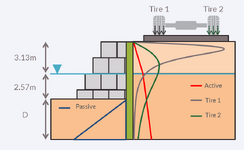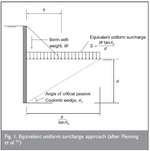TymProkopovych
Structural
- Apr 17, 2025
- 6
Hello Community! It is my first time posting here, and I hope I can get some help with this interesting sheet pile case.
I am evaluating a proposed causeway by a marine contractor that utilized sheet piles to retain a roadway embankment. I have attached a sketch of my analysis model for reference. At first, I neglected any resisting effect from the concrete blocks (around 1x1m), and determined the required penetration depth using Teng's simplified method for cantilever sheet piles on granular soils. The result was a total sheet pile length of around 15m, which does not sit well with the contractor, as they want to avoid splicing (for lengths beyond 6m).
Hence, I would like to clarify if:
1) I may use the concrete block facing to aid in reducing the sheet pile length (i.e. by resisting the lateral pressures acting on the full height of its side)?
2) If that is the case, how will it modify my initial analysis considering the usual setup of cantilever sheet piles (where the unbackfilled side doesn't have any resisting element)?
Thank you so much!
I am evaluating a proposed causeway by a marine contractor that utilized sheet piles to retain a roadway embankment. I have attached a sketch of my analysis model for reference. At first, I neglected any resisting effect from the concrete blocks (around 1x1m), and determined the required penetration depth using Teng's simplified method for cantilever sheet piles on granular soils. The result was a total sheet pile length of around 15m, which does not sit well with the contractor, as they want to avoid splicing (for lengths beyond 6m).
Hence, I would like to clarify if:
1) I may use the concrete block facing to aid in reducing the sheet pile length (i.e. by resisting the lateral pressures acting on the full height of its side)?
2) If that is the case, how will it modify my initial analysis considering the usual setup of cantilever sheet piles (where the unbackfilled side doesn't have any resisting element)?
Thank you so much!


